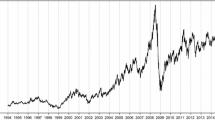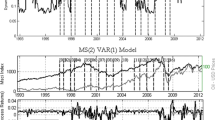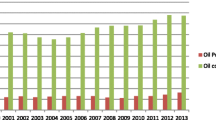Abstract
In this paper, we employ the generalized autoregressive conditional heteroscedasticity-mixed data sampling (GARCH-MIDAS) framework to forecast the daily volatility of state-level stock returns in the United States (US) based on structurally decomposed four monthly oil shocks associated with oil supply, global economic activity, oil consumption and oil inventory. We find that over the daily period of (February) 1994 to (December) 2022 and various forecast horizons, in 46 out of the 50 states, the GARCH-MIDAS model with at least one oil shock can outperform the benchmark, i.e., the GARCH-MIDAS-Realized Volatility (RV), with 24 states depicting the importance of all the four shocks. In general, oil market-specific shocks, whether supply or demand, tend to matter more than a global economic impact driving the oil market in forecasting volatility of regional stock returns across with better forecasting performances related to states with higher CO2 emissions based on underlying energy consumption data. Our findings have important implications for investors and policymakers, with the observations for the former group depicted by an analysis of economic significance, i.e., utility gains.
Similar content being viewed by others
Notes
For instance, Dai and Tang (2024) recently show that the impact of oil supply shock on the systemic risk of stock markets is insignificant, while it is significant for demand shock. This is also reinforced by Hanif et al. (2024), where demand-related shocks have the most significant spillover effects on stock markets. However, Castro and Jiménez-Rodríguez (2024) highlight the role of an intervening variable, such as oil inventories, as a modifier of oil-specific demand shocks. The latter evidence further validates the consideration of additional oil shock variants in our paper beyond oil supply and demand shocks.
The corresponding results for the BRICS countries, i.e., Brazil, Russia, India, China and South Africa, as obtained by Salisu and Gupta (2021), were quite heterogeneous.
There exists a large literature involving the utilization of variants of the GARCH-MIDAS models to predict daily aggregate and industry-level stock returns volatility in the US (and internationally as well), and the reader is referred to Salisu et al. (2022, forthcoming) and Segnon et al. (2023) for detailed reviews. Some other studies (see, for example, Conrad et al. (2018), Borup and Jakobsen (2019), Conrad and Kleen (2020), and Yu et al. (2023) among others) provide empirical use of the multiplicative GARCH-MIDAS model.
Ghysels et al. (2019) compare the GARCH and realized volatility methodologies by producing multi-period-ahead forecasts and conclude that the MIDAS-based model yields the most precise forecasts of in-and out-of-sample volatility.
Oil Supply Shocks \(\left({u}_{oss}={q}_{t}-{\alpha }_{qp}{p}_{t}-{b}_{1}{\prime}{x}_{t-1}\right)\) measures the distortions/changes in the supply of oil; Economic Activity Shock \(\left({u}_{eas}={y}_{t}-{\alpha }_{yp}{p}_{t}-{b}_{2}{\prime}{x}_{t-1}\right)\) measures the distortions/changes in economic performance; Oil Consumption Demand Shock \(\left({u}_{\text{ocds}}={q}_{t}-{\beta }_{qy}{y}_{t}-{\beta }_{qp}{p}_{t}-\Delta {i}_{t}^{*}-{b}_{3}{\prime}{x}_{t-1}\right)\) measures the distortions/changes in the quantity of oil demanded for specific purpose(s)—consumption; and Oil Inventory Demand Shock \(\left({u}_{\text{oids}}=\Delta {i}_{t}^{*}-{\psi }_{1}^{*}{q}_{t}-{\psi }_{2}^{*}{y}_{t}-{\psi }_{3}^{*}{p}_{t}-{b}_{4}{\prime}{x}_{t-1}\right)\) measures the distortions/changes in the produced oil that is returned to inventory; where \({q}_{t}=100ln\left({Q}_{t}/{Q}_{t-1}\right)\) denotes the growth rate of oil production; \(\Delta {i}_{t}^{*}=100\left(\Delta {I}_{t}^{*}/{Q}_{t-1}\right)\) is the approximation of growth in consumption demand, where \(\Delta {I}_{t}^{*}={Q}_{t}^{S}-{Q}_{t}^{D}\), with \({Q}_{t}^{S}\) and \({Q}_{t}^{D}\) representing quantity supplied and demanded, respectively; \({y}_{t}\) is the cost of international ship** deflated by the US Consumer Price Index (CPI) and reported in deviations from a linear trend; \({p}_{t}\) is the log difference between the refiner acquisition cost of crude oil imports and the US CPI; \({x}_{t-1}\) are the lagged values of all the variables over the preceding two years (see, Baumeister and Hamilton (2019) for full details).
The data is downloadable from the internet page of Professor Christiane Baumeister at: https://sites.google.com/site/cjsbaumeister/research.
This is obtained from the two-parameter beta weighting scheme \({\phi }_{k}\left({\omega }_{1},{\omega }_{2}\right)={\left[k/\left(K+1\right)\right]}^{{\omega }_{1}-1}\times {\left[1-k/\left(K+1\right)\right]}^{{\omega }_{2}-1}/{\sum }_{j=1}^{K}{\left[j/\left(K+1\right)\right]}^{{\omega }_{1}-1}\times {\left[1-j/\left(K+1\right)\right]}^{{\omega }_{2}-1}\) by constraining \({\omega }_{1}\) to 1 and setting \(\omega ={\omega }_{2}\).
The economic conditions indexes (ECIs) of the 50 US states are based on the work of Baumeister et al. (2022). These authors derive the indexes from mixed-frequency Dynamic Factor Models (DFMs) with weekly, monthly, and quarterly variables that cover multiple dimensions of the aggregate and the state economies. Specifically, Baumeister et al. (2022) group variables into six broad categories: mobility measures, labor market indicators, real economic activity, expectations measures, financial indicators, and household indicators. Table 1 in their paper summarize the state-level data that they use in the construction of the ECIs, and also include information on the frequency, source, transformation, seasonal adjustment, and the start date of each underlying data series utilized in the construction of the indexes. While the same for the aggregate US, i.e., for the national ECI, can be found in Table 4 in the Appendix of the paper of Baumeister et al. (2022). The indexes are scaled to 4-quarter growth rates of US real GDP and normalized such that a value of zero indicates national long-run growth. Note that these indexes are weekly, but as we combine them with the monthly oil shocks, we conver them to monthly by taking weekly averages over a particular month. The data is available for download from: https://sites.google.com/view/weeklystateindexes/dashboard.
Our paper recognizes the concern that value-weighted portfolios, which are typical for constructing indices, might disproportionately reflect the performance of large, nationally operating firms, thereby potentially capturing national rather than local shocks. However, this approach is adopted not to overlook the influence of large firms but to ensure that our analysis mirrors the actual investment landscape where these firms play a significant role. It is important to acknowledge that even though large companies may operate nationally or even globally, their economic activities—including investment, employment, and production—can have pronounced impacts on the states where they are headquartered. These activities can influence local economies and, by extension, the state-level stock market indices. Hence, while national shocks undoubtedly affect these indices, the impacts of such shocks can still provide valuable insights into state-level market dynamics, particularly how local economies and stock markets respond to changes in the national economic environment.
In fact, we created five metrics of entropy-based networks of the long-term volatilities across the US states, with one each corresponding to the GARCH-MIDAS-RV and the GARCH-MIDAS with the four oil shocks. Based on the correlation matrices, we perform a singular value decomposition and compute the entropy as in Caraiani (2018). The computation is done using a sliding window with a size of one year such that we can obtain a time series of the networks. When we related the five networks to the daily Aruoba-Diebold-Scotti (ADS; Arouba et al. 2009) business conditions index (designed to track real business conditions at high observation frequency), using ordinary least square (OLS) regressions (over March 1995 to December 2022), with heteroskedasticity and autocorrelation corrected (HAC) standard errors (Newey and West 1987), we found that the responses (with p-values), due to RV, OSS, EAS, OCDS, OIDS-based network of volatility respectively, were: 0.2495 (0.1515), 0.4670 (0.0066), 0.7637 (0.0109), 0.3534 (0.1881), -0.3206 (0.0157). In other words, volatility networks due to positive supply and global economic activity shocks, resulting in an oil price increase, can be considered good news and increase the ADS, while an oil price rise due to an oil-inventory demand shock is bad news. Therefore, the associated volatility network reduces the ADS. Interestingly, the volatility network of oil-specific consumption demand shock has an insignificant impact, just like that of the RV, with the latter finding being in line with superior forecasting performances of the oil shocks-based GARCH-MIDAS models relative to the GARCH-MIDAs-RV. Note the ADS index is available for download from https://www.philadelphiafed.org/surveys-and-data/real-time-data-research/ads. Complete details of these results are available upon request from the authors.
References
Antonakakis N, Chatziantoniou I, Filis G (2017) Oil shocks and stock markets: dynamic connectedness under the prism of recent geopolitical and economic unrest. Int Rev Financ Anal 50(3):1–26
Aruoba SB, Diebold FX, Scotti C (2009) Real-time measurement of business conditions. J Bus Econ Stat 27(4):417–427
Bańbura M, Giannone D, Reichlin L (2011) Nowcasting. In: Clements MP, Hendry DF (eds) Oxford Handbook on Economic Forecasting. Oxford University Press, pp 63–90
Bastianin A, Manera M (2018) How does stock market volatility react to oil shocks? Macroecon Dyn 22(3):666–682
Bastianin A, Conti F, Manera M (2016) The impacts of oil price shocks on stock market volatility: evidence from the G7 countries. Energy Policy 98:160–169
Baumeister C, Hamilton JD (2019) Structural interpretation of vector autoregressions with incomplete identification: revisiting the role of oil supply and demand shocks. Am Econ Rev 109(5):1873–1910
Baumeister C, Leiva-León D, Sims E (2022) Tracking weekly state-level economic conditions. Rev Econ Stat. https://doi.org/10.1162/rest_a_01171
Bernanke BS (1983) Irreversibility, uncertainty, and cyclical investment. Quart J Econ 98(1):85–106
Bloom NA (2009) The impact of uncertainty shocks. Econometrica 77(3):623–685
Bonato M, Cepni O, Gupta R, Pierdzioch C (2023) Climate risks and state-level stock market realized volatility. J Financ Markets. https://doi.org/10.1016/j.finmar.2023.100854
Borup D, Jakobsen JS (2019) Capturing volatility persistence: a dynamically complete realized EGARCH-MIDAS model. Quant Finan 19(11):1839–1855
Caraiani P (2018) Modeling the comovement of entropy between financial markets. Entropy 20(6):417
Castro C, Jiménez-Rodríguez R (2024) The impact of oil shocks on the stock market. Glob Financ J 60:100967. https://doi.org/10.1016/j.gfj.2024.100967
Chaney T, Sraer D, Thesmar D (2012) The collateral channel: how real estate shocks affect corporate investment. American Economic Review 102(6):2381–2409
Clements MP, Galvão AB (2008) Macroeconomic forecasting with mixed-frequency data. J Bus Econ Stat 26(4):546–554
Colacito R, Engle RF, Ghysels E (2011) A component model for dynamic correlations. J Econ 164(1):45–59
Conrad C, Kleen O (2020) Two are better than one: Volatility forecasting using multiplicative component GARCH-MIDAS models. J Appl Economet 35(1):19–45
Conrad C, Custovic A, Ghysels E (2018) Long- and short-term cryptocurrency volatility components: a GARCH-MIDAS analysis. J Risk Financ Manag 11:23
Coval JD, Moskowitz TJ (1999) Home bias at home: local equity preference in domestic portfolios. J Finan 54(6):2045–2073
Coval JD, Moskowitz TJ (2001) The geography of investment: informed trading and asset prices. J Polit Econ 199(4):811–841
Dai Z, Tang R (2024) The impact of oil price shocks on systematic risk of G7 stock markets. Expert Syst Appl 248:123408. https://doi.org/10.1016/j.eswa.2024.123408
Degiannakis S, Filis G, Kizys R (2014) The effects of oil price shocks on stock market volatility: evidence from European data. Energy J 35(1):35–56
Degiannakis S, Filis G, Arora V (2018) Oil prices and stock markets: a review of the theory and empirical evidence. Energy J 39(5):85–130
Diebold FX, Mariano RS (1995) Comparing predictive accuracy. J Bus Econ Stat 13(3):253–263
Engle RF, Ghysels E, Sohn B (2013) Stock market volatility and macroeconomic fundamentals. Rev Econ Stat 95(3):776–797
Ghysels E, Valkanov R (2012) Forecasting Volatility with MIDAS. In: Bauwens L, Hafner C, Laurent S (eds) Handbook of Volatility Models and Their Applications. John Wiley & Sons Inc, Hoboken, New Jersey, United States, pp 383–401
Ghysels E, Plazzi A, Valkanov R, Rubia A, Dossani A (2019) Direct versus iterated multi-period volatility forecasts. Annu Rev Financ Econ 11:173–195
Hanif W, Hadhri S, El Khoury R (2024) Quantile spillovers and connectedness between oil shocks and stock markets of the largest oil producers and consumers. J Commod Mark 34:100404. https://doi.org/10.1016/j.jcomm.2024.100404
Harvey D, Leybourne S, Newbold P (1997) Testing the equality of prediction mean squared errors. Int J Forecast 13(2):281–291
Jung H, Park C (2011) Stock market reaction to oil price shocks: a comparison between an oil-exporting economy and an oil-importing economy. J Econ Theory Econ 22(3):1–29
Kilian L (2009) Not all oil price shocks are alike: disentangling demand and supply shocks in the crude oil market. Am Econ Rev 99(3):1053–1069
Kilian L, Park C (2009) The impact of oil price shocks on the US stock market. Int Econ Rev 50(4):1267–1287
Korniotis GM, Kumar A (2013) State-level business cycles and local return predictability. J Finan 68(3):1037–1096
Liu J, Ma F, Tang Y, Zhang Y (2019) Geopolitical risk and oil volatility: a new insight. Energy Econ 84:104548
Lu X, Ma F, Wang J, Zhu B (2021) Oil shocks and stock market volatility: new evidence. Energy Econ 103:105567
Ludvigson SC, Ma S, Ng S (2021) Uncertainty and business cycles: exogenous impulse or endogenous response? Am Econ J Macroecon 13(4):369–410
Newey WK, West KD (1987) A simple positive semi-definite, heteroscedasticity and autocorrelation consistent covariance matrix. Econometrica 55(3):703–708
Pirinsky C, Wang Q (2006) Does corporate headquarters location matter for stock returns? J Finan 61:1991–2015
Poon S-H, Granger CWJ (2003) Forecasting volatility in financial markets: a review. J Econ Lit 41(2):478–539
Rapach DE, Strauss JK, Wohar ME (2008) Forecasting stock return volatility in the presence of structural breaks, in Forecasting in the Presence of Structural Breaks and Model Uncertainty. In: Rapach DE, Wohar ME (eds) vol 3 of Frontiers of Economics and Globalization, Bingley, United Kingdom: Emerald, pp 381–416
Salisu AA, Gupta R (2021) Oil shocks and stock market volatility of the BRICS: a GARCH-MIDAS approach. Glob Financ J 48:100546
Salisu AA, Demirer R, Gupta R (2022) Financial turbulence, systemic risk and the predictability of stock market volatility. Glob Financ J 52:100699
Salisu AA, Demirer R, Gupta R (Forthcoming) Policy uncertainty and stock market volatility revisited: the predictive role of signal quality. J Forecast
Schwert GW (1989) Why does stock market volatility change over time? J Finan 44(5):1115–1153
Segnon M, Gupta R, Wilfling B (2023) Forecasting stock market volatility with regimeswitching GARCH-MIDAS: the role of geopolitical risks. Int J Forecast. https://doi.org/10.1016/j.ijforecast.2022.11.007
Shiller RJ (1981a) Do stock prices move too much to be justified by subsequent changes in dividends? Am Econ Rev 71(3):421–436
Shiller RJ (1981b) The use of volatility measures in assessing market efficiency. J Finan 36(2):291–304
Smyth R, Narayan PK (2018) What do we know about oil prices and stock returns? Int Rev Financ Anal 57:148–156
Acknowledgements
We would like to thank two anonymous referees for many helpful comments. However, any remaining errors are solely ours. The last author of the paper also thanks the support provided by a grant from the Ministry of Research, Innovation and Digitization, CNCS—UEFISCDI, Romania, project number PN-III-P1-1.1-TE-2021-1339, within PNCDI III.
Author information
Authors and Affiliations
Corresponding author
Ethics declarations
Competing interests
The authors declare that they have no known competing financial interests or personal relationships that could have appeared to influence the work reported in this paper.
Additional information
Publisher's Note
Springer Nature remains neutral with regard to jurisdictional claims in published maps and institutional affiliations.
Appendix
Appendix
Table
Table
Table
Rights and permissions
Springer Nature or its licensor (e.g. a society or other partner) holds exclusive rights to this article under a publishing agreement with the author(s) or other rightsholder(s); author self-archiving of the accepted manuscript version of this article is solely governed by the terms of such publishing agreement and applicable law.
About this article
Cite this article
Salisu, A.A., Gupta, R., Cepni, O. et al. Oil shocks and state-level stock market volatility of the United States: a GARCH-MIDAS approach. Rev Quant Finan Acc (2024). https://doi.org/10.1007/s11156-024-01295-z
Accepted:
Published:
DOI: https://doi.org/10.1007/s11156-024-01295-z




